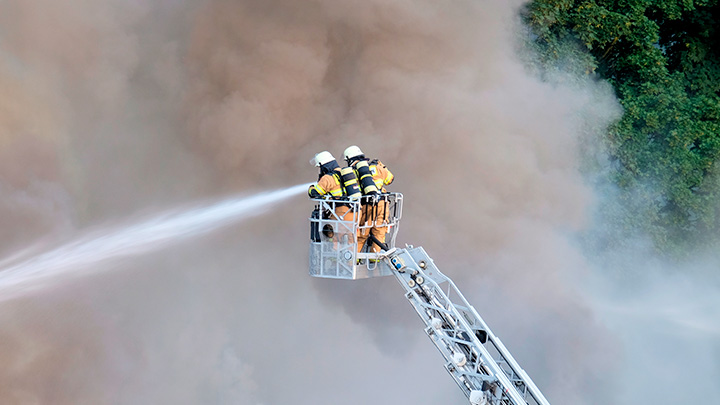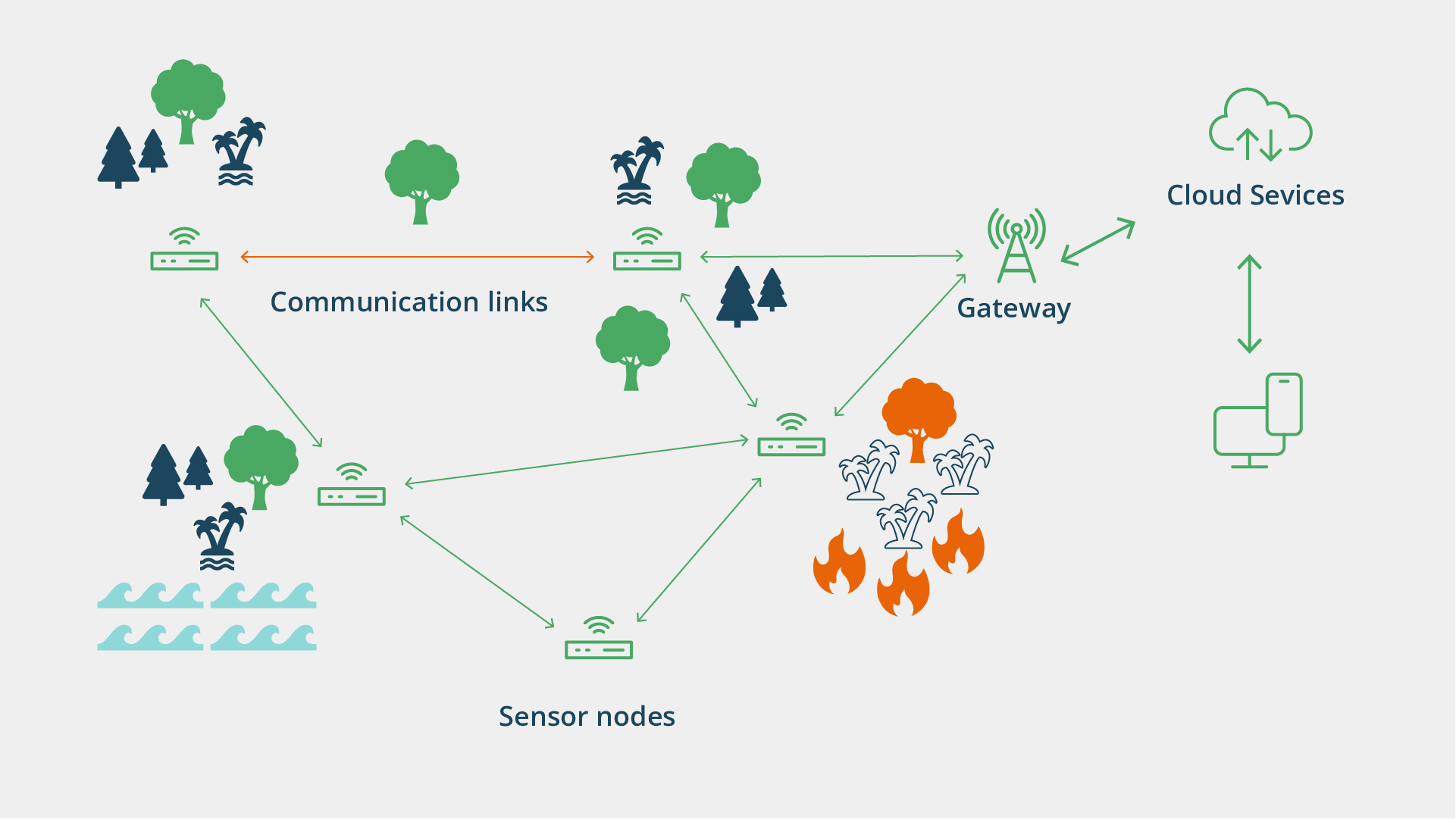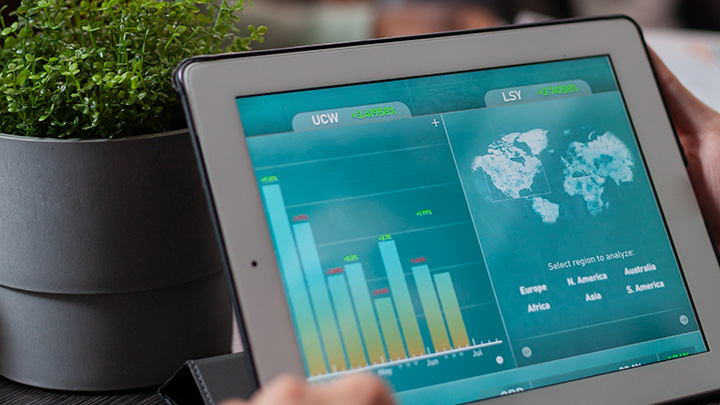
Natural disasters are becoming more frequent and severe, emphasizing the need for risk reduction. The UN Office for Disaster Risk Reduction estimates that every dollar spent on prevention saves $15 on recovery. More directly, each dollar invested in strong infrastructure cuts rebuilding costs by $4. This shows the value of IoT solutions, which provide quick detection, constant monitoring, and better coordination during emergencies.
We’ll explore how Internet of Things (IoT) is changing disaster management, look at specific examples, and explain how to add IoT to your existing strategies.
IoT in disaster management means using connected devices—sensors, wearables, drones, and communication tools—to gather and analyze data instantly. This allows us to detect, prepare for, and respond to disasters. IoT devices make it possible to predict and detect dangerous situations like floods, wildfires, and earthquakes early.

Sensor deployment and information transmission.
Source: Hindawi
Here are six key ways IoT is being applied to disaster management right now:
IoT sensors can warn authorities about upcoming disasters like floods, earthquakes, and severe weather. This significantly shortens the time between detection and response.
Sensors in risky areas monitor things like water levels and wind speeds, sending data to central dashboards. Some earthquake warning systems only alert when ground movement is above magnitude 2, avoiding false alarms from minor tremors.
When every second counts, real-time monitoring reduces damage impact. IoT sensors help emergency systems notify people, evacuate areas, and direct resources.
Good preparation helps to minimize short term damage as well as long-term disruptions. IoT adds automatic triggers to readiness strategies, therefore ensuring efficient use of resources including supplies and medical aid.
Combining real-time sensor measurements with past disaster data, predictive models project the degree of an event. Emergency systems can thus automatically deliver supplies and rescue teams to the most important places.
After a disaster, assessing damage accurately is vital for prioritizing relief and rebuilding. IoT devices, especially drones and imaging sensors, gather detailed information quickly and safely, without putting people at risk.
While IoT cameras and GPS devices on ground evaluate structural damage, roadblocks, and other hazards, drones offer aerial views of impacted areas. Combining this information into mapping tools enables rescue crews to locate victims and create sensible paths.
Communication often fails first in disasters, hindering relief efforts. Until conventional infrastructure is restored, IoT-based mesh networks and satellite devices can fill in to provide dependable communication.
Temporary networks created by portable IoT gateways span impacted areas. These devices keep rescue crews organized by sending data to emergency command centers using several wireless technologies including Wi-Fi, LoRaWAN, and cellular.
Making critical infrastructure—roads, bridges, power grids—more resilient reduces the long-term effects of disasters. IoT energy management and structural health sensors help find damage early and improve recovery.
Infrastructure sensors detect structural stress, temperature, and electrical problems. If anomalies are noticed (e.g., bridge fractures), the system tells local authorities immediately so they can act before a small problem becomes a major calamity.

The four phases of disaster management.
Source: Scholarly Community Encyclopedia
To enhance flood monitoring, NASA’s JPL and Thailand’s Hydro and Agro Informatics Institute developed the Flood SensorWeb. This Internet of Things system detects and predicts floods using ground sensors, MODIS, and Landsat satellite imagery. The 2010–2011 floods in Thailand affected more than 7 million people, caused more than 200 fatalities, and cost $1.67 billion in damages. The following year, there were nearly 600 fatalities and $45.7 billion in losses. The Flood SensorWeb has provided over 100 analytical tools across multiple flood seasons, improving preparedness and disaster response.
Launched in 2021, Watch Duty is a free, real-time wildfire tracking application developed by John Clarke Mills, CEO of the nonprofit behind the app. The app provides users across 22 states with up-to-date information on wildfires, including perimeters, evacuation zones, and air quality. During the Palisades fire in January 2025, Watch Duty became a crucial tool for both residents and official emergency services, highlighting its effectiveness in disaster response. By the end of 2024, the app had reached over 7 million users and raised $5.6 million in funding. In a single 10-hour period during the Los Angeles wildfires, it gained 750,000 new users, underscoring its critical role in providing timely information during emergencies.
IoT presents great opportunities, but effective integration calls for careful preparation. Implementing IoT in disaster management calls for addressing technical, infrastructure, and social aspects as well.
Check your current systems for emergency response. Look for areas where IoT—such as drone surveillance or flood monitoring sensors—may offer quick advantages.
Choose hardware (sensors, drones, communication tools) and software (cloud platforms, analytics tools) compliant with industry norms for emergency response. Think about their scalability and how they cooperate.
IoT in disaster response relies on consistent connections. Plan for backup communication should main networks fail and strong network security to safeguard data.
Make sure community leaders and responders are adept in using the new methods. This covers everything from running drone cameras to grasping real-time monitoring dashboards.
Start with a high-risk area pilot project. Track its performance, hone your strategy, then start to grow. Constant assessment maintains the system efficient and flexible enough to meet new challenges.
Kanda has extensive experience delivering advanced IoT solutions tailored to organizational needs. We ensure secure data flows, robust analytics, and scalable infrastructure.
Talk to an expert to explore how we can tailor a custom IoT solution to strengthen your disaster resilience strategy.
IoT is changing disaster prediction, monitoring, and response. Responders use real-time monitoring, networked sensors, and advanced analytics to identify hazards, dispatch resources, and limit damage.
IoT technology will be essential for flood monitoring, wildfire management, earthquake early warnings, and more. It saves lives, protects infrastructure, and reduces recovery costs so that we can live in a safer world.



